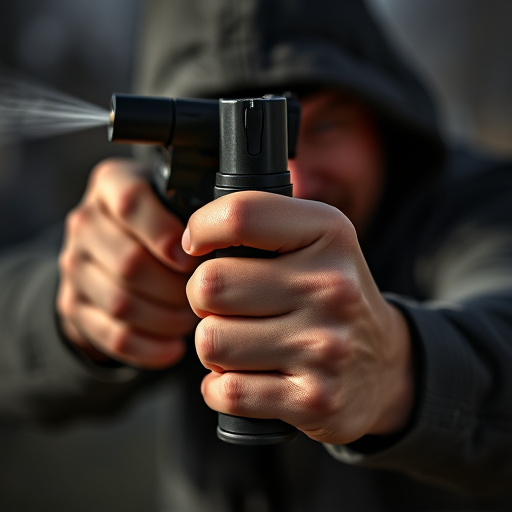Pepper spray, a non-lethal crowd control tool, derives from capsicum plants and contains capsaicin, temporarily incapacitating individuals for 30 seconds to 1 minute. Understanding its effects is vital for both police and the public, as symptoms like coughing and difficulty breathing can last up to 15 minutes. Used responsibly after de-escalation tactics fail, pepper spray should only target specific individuals, with its potency influenced by temperature, humidity, and line of sight. Proper training and protocol are essential to ensure effective crowd control while minimizing harm and providing appropriate aftercare.
In recent years, pepper spray has emerged as a prominent tool in crowd control strategies employed by law enforcement agencies worldwide. This article delves into the effectiveness of pepper spray as a means of managing public gatherings and ensuring officer safety. We explore ‘How Long Pepper Spray Effects Last’ and provide insights on its application, duration, and the crucial safety measures to consider when using this powerful tool. By understanding these aspects, we can navigate crowd control more effectively and responsibly.
- Understanding Pepper Spray: A Tool for Crowd Control
- The Duration of Pepper Spray Effects: What You Need to Know
- Safety Measures and Considerations When Using Pepper Spray for Crowd Control
Understanding Pepper Spray: A Tool for Crowd Control
Pepper spray, officially known as oleoresin capsicum (OC) spray, is a non-lethal crowd control agent used by law enforcement to temporarily incapacitate individuals during disturbances or riots. This substance is derived from the capsicum plant and contains capsaicin, the chemical responsible for the burning sensation it causes. When deployed, pepper spray creates a disorienting effect, enabling officers to gain control of an unpredictable situation.
The effects of pepper spray are designed to be temporary, typically lasting between 30 seconds to 1 minute. During this time, individuals may experience coughing, tears, difficulty breathing, and temporary blindness. It is crucial for both police and the public to understand that while pepper spray is effective in crowd control, its use should be a last resort and only when other de-escalation tactics have failed. Knowing How Long Pepper Spray Effects Last can help by providing insights into the short-lived but intense impact it has on crowd dynamics.
The Duration of Pepper Spray Effects: What You Need to Know
Pepper spray, a common crowd control measure used by law enforcement, is designed to temporarily incapacitate individuals and disperse gatherings quickly. However, understanding the duration of its effects is crucial for both those in charge of public safety and the general public. The active ingredient in pepper spray, capsaicin, stimulates nerve endings, causing an intense burning sensation and temporary blindness. This disruption can last anywhere from 3 to 15 minutes, depending on various factors such as concentration, delivery method, and environmental conditions.
While the effects are meant to be short-lived, it’s important to recognize that individuals affected may require immediate medical attention if symptoms persist beyond expected limits or become severe. Exposure to pepper spray can lead to coughing, difficulty breathing, nausea, and in some cases, more serious health issues, especially for those with pre-existing respiratory conditions. Knowing how long the effects last is essential for ensuring timely de-escalation strategies and appropriate aftercare measures during crowd control situations.
Safety Measures and Considerations When Using Pepper Spray for Crowd Control
When employing pepper spray for crowd control, it’s paramount to prioritize safety and understand its impact. This tactic should only be utilized as a last resort when other de-escalation methods have failed. Police officers are trained to assess situations critically, ensuring the potential risks are outweighed by the need for intervention. The effects of pepper spray typically last for a short period, usually around 20-45 minutes, during which time individuals affected will experience irritation and temporary incapacitation. This limited duration is a crucial consideration, as it highlights the importance of swift and targeted use, minimizing harm to bystanders and those not involved in the incident.
The safety of both officers and civilians should guide every decision. Pepper spray can cause severe discomfort, breathing difficulties, and even panic attacks in some individuals. Therefore, police must be mindful of environmental factors such as temperature and humidity, which can affect the potency and duration of the spray. Additionally, ensuring a clear line of sight to minimize the risk of accidental discharge is essential. Proper training and adherence to protocol are vital to guarantee that pepper spray is deployed effectively and responsibly, balancing crowd control with public safety.
Police pepper spray is a powerful tool for crowd control, but its effects only last for a short duration. Understanding how long these effects persist is crucial for ensuring safety and minimizing harm during public disturbances. By adhering to proper safety measures and considering the context of use, law enforcement can effectively manage crowds while mitigating the risks associated with pepper spray.
